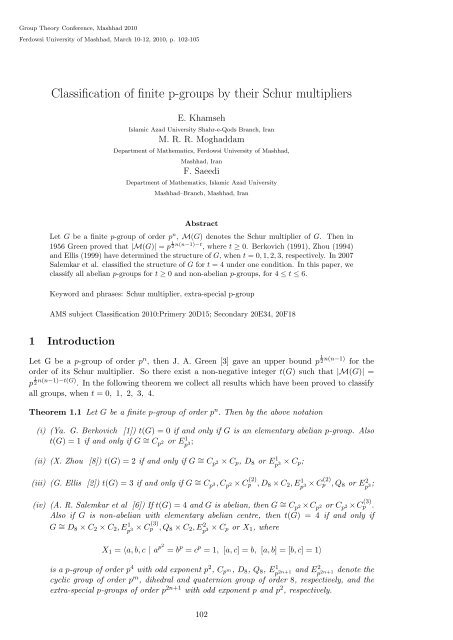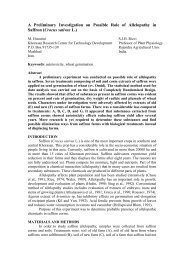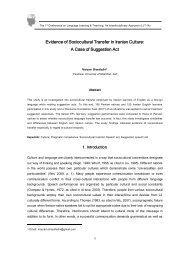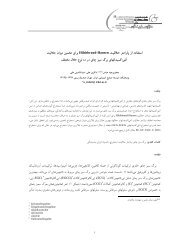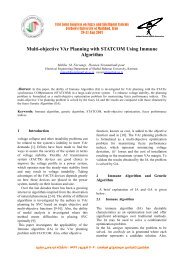Classification of finite p-groups by their Schur multipliers
Classification of finite p-groups by their Schur multipliers
Classification of finite p-groups by their Schur multipliers
You also want an ePaper? Increase the reach of your titles
YUMPU automatically turns print PDFs into web optimized ePapers that Google loves.
Group Theory Conference, Mashhad 2010<br />
Ferdowsi University <strong>of</strong> Mashhad, March 10-12, 2010, p. 102-105<br />
<strong>Classification</strong> <strong>of</strong> <strong>finite</strong> p-<strong>groups</strong> <strong>by</strong> <strong>their</strong> <strong>Schur</strong> <strong>multipliers</strong><br />
E. Khamseh<br />
Islamic Azad University Shahr-e-Qods Branch, Iran<br />
M. R. R. Moghaddam<br />
Department <strong>of</strong> Mathematics, Ferdowsi University <strong>of</strong> Mashhad,<br />
Mashhad, Iran<br />
F. Saeedi<br />
Department <strong>of</strong> Mathematics, Islamic Azad University<br />
Mashhad–Branch, Mashhad, Iran<br />
Abstract<br />
Let G be a <strong>finite</strong> p-group <strong>of</strong> order p n , M(G) denotes the <strong>Schur</strong> multiplier <strong>of</strong> G. Then in<br />
1956 Green proved that |M(G)| = p 1<br />
2 n(n−1)−t , where t ≥ 0. Berkovich (1991), Zhou (1994)<br />
and Ellis (1999) have determined the structure <strong>of</strong> G, when t = 0, 1, 2, 3, respectively. In 2007<br />
Salemkar et al. classified the structure <strong>of</strong> G for t = 4 under one condition. In this paper, we<br />
classify all abelian p-<strong>groups</strong> for t ≥ 0 and non-abelian p-<strong>groups</strong>, for 4 ≤ t ≤ 6.<br />
Keyword and phrases: <strong>Schur</strong> multiplier, extra-special p-group<br />
AMS subject <strong>Classification</strong> 2010:Primery 20D15; Secondary 20E34, 20F18<br />
1 Introduction<br />
Let G be a p-group <strong>of</strong> order p n , then J. A. Green [3] gave an upper bound p 1<br />
2 n(n−1) for the<br />
order <strong>of</strong> its <strong>Schur</strong> multiplier. So there exist a non-negative integer t(G) such that |M(G)| =<br />
p 1<br />
2 n(n−1)−t(G) . In the following theorem we collect all results which have been proved to classify<br />
all <strong>groups</strong>, when t = 0, 1, 2, 3, 4.<br />
Theorem 1.1 Let G be a <strong>finite</strong> p-group <strong>of</strong> order p n . Then <strong>by</strong> the above notation<br />
(i) (Ya. G. Berkovich [1]) t(G) = 0 if and only if G is an elementary abelian p-group. Also<br />
t(G) = 1 if and only if G ∼ = C p 2 or E 1 p 3;<br />
(ii) (X. Zhou [8]) t(G) = 2 if and only if G ∼ = C p 2 × Cp, D8 or E 1 p 3 × Cp;<br />
(iii) (G. Ellis [2]) t(G) = 3 if and only if G ∼ = C p 3, C p 2 × C (2)<br />
p , D8 × C2, E 1 p 3 × C (2)<br />
p , Q8 or E 2 p 3;<br />
(iv) (A. R. Salemkar et al [6]) If t(G) = 4 and G is abelian, then G ∼ = C p 2 ×C p 2 or C p 2 ×C (3)<br />
p .<br />
Also if G is non-abelian with elementary abelian centre, then t(G) = 4 if and only if<br />
G ∼ = D8 × C2 × C2, E 1 p 3 × C (3)<br />
p , Q8 × C2, E 2 p 3 × Cp or X1, where<br />
X1 = 〈a, b, c | a p2<br />
= b p = c p = 1, [a, c] = b, [a, b] = [b, c] = 1〉<br />
is a p-group <strong>of</strong> order p 4 with odd exponent p 2 , Cp m, D8, Q8, E 1 p 2n+1 and E 2 p 2n+1 denote the<br />
cyclic group <strong>of</strong> order p m , dihedral and quaternion group <strong>of</strong> order 8, respectively, and the<br />
extra-special p-<strong>groups</strong> <strong>of</strong> order p 2n+1 with odd exponent p and p 2 , respectively.<br />
102
E. Khamseh, M. R. R. Moghaddam and F. Saeedi 103<br />
In the present paper, using GAP programma [7] in some stages we determine all non-abelian<br />
p-<strong>groups</strong> for which 4 ≤ t(G) ≤ 6, and <strong>by</strong> omitting the condition for the case t(G) = 4 in [6] we<br />
have also found some new <strong>groups</strong>.<br />
To prove the main results, we need the following results (see also [5]).<br />
Theorem 1.2 (<strong>Schur</strong> 1907) For every <strong>finite</strong> <strong>groups</strong> H and K, we have<br />
M(H × K) ∼ = M(H) × M(K) × H<br />
H ′ ⊗ K<br />
K ′<br />
Lemma 1.1 [4] Let G be a d generator p-group <strong>of</strong> order p n , then<br />
p 1<br />
2 d(d−1) ≤ |G ′<br />
||M(G)| ≤ p 1<br />
2 n(n−1) .<br />
Proposition 1.1 [2] Let G be a d-generator group <strong>of</strong> order p n with derived subgroup <strong>of</strong> order<br />
p c and its central factor is a δ-generator group. Then<br />
2 Main Results<br />
|M(G)| ≤ p 1<br />
2 [d(2n−2c−d−1)+2(δ−1)c]<br />
Throughout the rest <strong>of</strong> the paper we always assume that G is a d-generator p-group <strong>of</strong> order pn with |M(G)| = p 1<br />
2 n(n−1)−t(G) and G ′ <strong>of</strong> order pc . We also assume that G<br />
Z(G) is a δ- generator<br />
and the Frattini subgroup Φ(G), is <strong>of</strong> order pa . It is clear that a = n − d.<br />
By the above notations inequality (1) implies that<br />
Since d ≥ δ, we have<br />
2(t − c(d + 1 − δ)) ≥ a 2 − a a ≥ c ≥ 0 (2)<br />
(1)<br />
2(t − c) ≥ a 2 − a. (3)<br />
In this section, we first determine the structure <strong>of</strong> abelian p-<strong>groups</strong> G in terms <strong>of</strong> the orders<br />
<strong>of</strong> Frattini subgroup and its <strong>Schur</strong> multiplier, for all t(G) ≥ 0. Also when G is a non-abelian<br />
p-group we characterize the structure <strong>of</strong> G, <strong>by</strong> considering different possible choices <strong>of</strong> (c, a) in<br />
inequality (3) when 4 ≤ t ≤ 6.<br />
In the following result we characterize all abelian p-<strong>groups</strong>, for which t ≥ 0. Let G is a <strong>finite</strong><br />
abelian p-group, then we can write G ∼ = Cpn1 × ... × Cpnk × C n−(a+k)<br />
p , where n1 + ... + nk = a + k,<br />
if G is not elementary abelian then ni ≥ 2 and 1 ≤ k ≤ a.<br />
Theorem 2.1 By the above notations if G be a <strong>finite</strong> abelian p-group <strong>of</strong> order p n and |Φ(G)| =<br />
p a then<br />
(i) t = 0 if and only if G ∼ = C (n)<br />
p ;<br />
(ii) t > 0 if and only if<br />
G ∼ = Cp n 1 × ... × Cp n k × C (l)<br />
p ,<br />
in which l is non-negative integer equal to t<br />
a − (a+k)2−(a+k)−2m 2a<br />
Theorem 2.2 Let G be a non-abelian p-group <strong>of</strong> order p n , then<br />
and |M(Cp n 1 × ... × Cp n k )| = p m .
104 <strong>Classification</strong> <strong>of</strong> <strong>finite</strong> p-<strong>groups</strong> <strong>by</strong> <strong>their</strong> . . .<br />
(a) t(G) = 4 if and only if<br />
G ∼ = Q8 × C2, D8 × C (2)<br />
2 , T1, T4 (p = 2), and<br />
G ∼ = E 1 p 3 × C (3)<br />
p , E 2 p 3 × Cp, X1, X4, X5, X6, Y3 (p = 2);<br />
(b) t(G) = 5 if and only if<br />
G ∼ = Q8 × C (2)<br />
2 , D8 × C (3)<br />
2 , T4 × C2, T2, E 1 2 5, E 2 2 5, D16 (p = 2), and<br />
G ∼ = E 1 p 3 × C (4)<br />
p , E 2 p 3 × C (2)<br />
p , E 1 p 5, E 2 p 5, X4 × Cp, X2, X7, X8, X9 (p = 2);<br />
(c) t(G) = 6 if and only if<br />
G ∼ = Q8 × C (3)<br />
2 , D8 × C (4)<br />
2 , T4 × C (2)<br />
2 , E1 2 5 × C2, E 2 2 5 × C2, T3, (C2 × ((C4 × C2) ⋊ C2)) ⋊<br />
C2, C2 × ((C4 × C2) ⋊ C2), QD16, Q16, C (4)<br />
2 ⋊ C2, (C4 × C4) ⋊ C2 (p = 2), and<br />
G ∼ = E 1 p 3 × C (5)<br />
p , E 2 p 3 × C (3)<br />
p , E 1 p 5 × Cp, E 2 p 5 × Cp, X4 × C (2)<br />
p , (Cp × ((C p 2 × Cp) ⋊ Cp)) ⋊<br />
Cp, X3, Y1, Y2, Y4 (p = 2);<br />
where X , , ,<br />
is, T i s and Y i s are described in tables I, II and III for <strong>groups</strong> <strong>of</strong> order p4 , for p odd,<br />
even and <strong>groups</strong> <strong>of</strong> order p5 respectively.<br />
TABLE I<br />
Name Relations<br />
X1<br />
X2<br />
X3<br />
X4<br />
X5<br />
X6<br />
X7<br />
X8<br />
X9<br />
TABLE II<br />
a p2 = b p = c p = 1, [a, c] = b, [a, b] = [b, c] = 1<br />
a p2 = b p2 = 1, [a, b] = a p<br />
a p3 = b p = 1, [a, b] = a p2<br />
a p2 = b p = c p = 1, [b, c] = a p ,<br />
a 9 = b 3 = c 3 = 1, [a, b] = 1, [a, c] = b, c −1 bc = a −3 b<br />
a p = b p = c p = d p = 1, [c, d] = b, [b, d] = a, [a, b] = [a, d] = [b, c] = [a, c] = 1 (p > 3)<br />
a p2 = b p = c p = 1, [a, c] = b, [b, c] = 1, [a, b] = a p<br />
a p2 = b p = 1, c p = a p , [a, c] = b, [b, c] = 1, [a, b] = a p<br />
a p2 = b p = 1, c p = a αp , [a, c] = b, [b, c] = 1, [a, b] = a p ( α = 0, 1 and non residue mod p )<br />
Name Relations<br />
T1 a 4 = b 2 = c 2 = 1, [a, c] = b, [a, b] = [b, c] = 1<br />
T2<br />
a 4 = b 4 = 1, [a, b] = a 2<br />
T3<br />
a 8 = b 2 = 1, [a, b] = a 4<br />
T4 a 4 = b 2 = c 2 = 1, [b, c] = a 2 , [a, b] = [a, c] = 1<br />
TABLE III<br />
Name Relations<br />
Y1 Cp × ((C<br />
p2 × Cp) ⋊ Cp)<br />
Y2 C<br />
p2 × ((Cp × Cp) ⋊ Cp)<br />
Y3<br />
C (4)<br />
p ⋊ Cp<br />
Y4 (Cp × ((Cp × Cp) ⋊ Cp)) ⋊ Cp<br />
References<br />
[1] Berkovich, Ya. G. , On the order <strong>of</strong> the commutator sub<strong>groups</strong> and the <strong>Schur</strong> multiplier <strong>of</strong><br />
a <strong>finite</strong> p-group, J. Algebra 144 (1991), 269-272.<br />
[2] Ellis, G. , On the <strong>Schur</strong> multiplier <strong>of</strong> p-<strong>groups</strong>, Comm. Algebra 27 no. 9, (1999), 4173–4177.
E. Khamseh, M. R. R. Moghaddam and F. Saeedi 105<br />
[3] Green, J. A. , On the number <strong>of</strong> automorphism <strong>of</strong> a <strong>finite</strong> group. Pro. Royal Soc. A 237<br />
(1956), 574–581.<br />
[4] Jones, M. R. , Some inequalities for the multiplicator <strong>of</strong> a <strong>finite</strong> group, Pro. Amer. Math.<br />
Soc. 39 (1973), 450–456.<br />
[5] Karpilovsky, G. , The <strong>Schur</strong> multiplier, LMS Monogrphs New Series 2. Oxford: Oxford<br />
University Press, 1987.<br />
[6] Salemkar, A. R, Moghaddam, M. R. R. , Davarpanah, M. and Saeedi, F. , A remark on the<br />
<strong>Schur</strong> multiplier <strong>of</strong> p-<strong>groups</strong>, Comm. Algebra 35 (2007), 1215–1221.<br />
[7] The GAP Group, GAP-Groups Algorithms and Programming, Version 4.4.12, 2008<br />
(http://www.gap-system.org/).<br />
[8] Zhou, X. , On the order <strong>of</strong> <strong>Schur</strong> <strong>multipliers</strong> <strong>of</strong> <strong>finite</strong> p-<strong>groups</strong>, Comm. Algebra 22 no. 1,<br />
(1994), 1–8.


